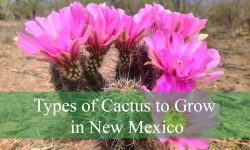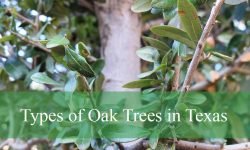Almond trees are a diverse group of nut-bearing trees that thrive in warm, dry climates. With various types of almond trees cultivated worldwide, each variety offers unique characteristics in terms of flavor, shell hardness, and adaptability. Some almonds are prized for their sweet, delicate taste, while others are preferred for their high resistance to pests and environmental conditions.
Understanding the different types of almond trees is essential for growers and enthusiasts looking to cultivate these nutritious nuts. From the widely popular Nonpareil to the gourmet Marcona and the frost-resistant Ferragnes, each variety has distinct growth habits, kernel quality, and blooming times. Proper identification ensures optimal planting and pollination strategies for a successful harvest.
In this guide, we will explore 16 types of almond trees, highlighting their key characteristics, identification features, and ideal growing conditions. Whether you’re a commercial grower or a home gardener, learning about these varieties will help you choose the best almond trees for your specific climate and needs.
Different Types of Almond Trees
Nonpareil

Nonpareil almonds are among the most popular and widely grown almond varieties, known for their thin shells and smooth, light-colored kernels. They are prized for their sweet flavor, making them ideal for snacking and confectionery products. This variety blooms early and requires cross-pollination with other almond types for optimal production.
Identifying Nonpareil almonds is relatively easy due to their distinctive elongated shape and smooth, paper-thin shells. The nuts are easily cracked open, revealing a uniform, pale kernel. The trees have a medium to large growth habit with spreading branches and produce a high yield when properly maintained.
Nonpareil almonds thrive in USDA hardiness zones 7-9, preferring warm, dry climates with well-drained soils. They require long, hot summers for optimal nut development and perform best in regions such as California’s Central Valley, where they are extensively cultivated.
Carmel

Carmel almonds are valued for their rich, sweet flavor and slightly darker kernel color compared to Nonpareil. They are commonly used in processing and baking due to their high oil content and consistent quality. This variety is a late-blooming almond that pairs well with Nonpareil for cross-pollination.
Carmel almonds can be identified by their slightly smaller, more rounded shape and firmer shell compared to Nonpareil. The kernels have a more wrinkled appearance and are often darker in color. The trees are moderately vigorous with an upright growth habit and good canopy structure.
Carmel almonds grow well in USDA zones 7-9, favoring warm, arid regions similar to Nonpareil. They are particularly well-adapted to California’s almond-growing regions and require regular irrigation and pruning to maintain healthy yields.
Mission

Mission almonds are known for their robust flavor and darker, wrinkled appearance, making them a preferred choice for roasting and flavoring. They have a harder shell compared to Nonpareil, providing better protection against pests and environmental factors. This variety blooms later than Nonpareil, reducing the risk of frost damage.
These almonds are easily recognized by their deep brown, rough-textured shells and smaller, more compact kernels. Mission almonds have a distinctive, slightly bitter taste that enhances their appeal when roasted or seasoned. The trees exhibit strong, upright growth and are known for their resilience.
Mission almonds thrive in USDA zones 7-9, performing well in Mediterranean climates with hot summers and mild winters. They are commonly grown in California and require well-drained soils with adequate irrigation to ensure consistent nut production.
Sonora
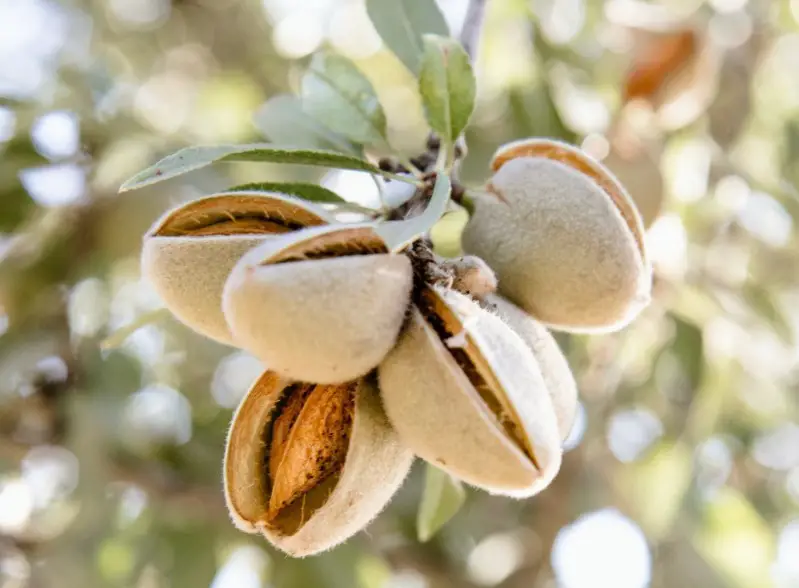
Sonora almonds are highly regarded for their large, elongated kernels and sweet, delicate flavor. Their thin shells make them easy to crack, and they are often used in premium snack products and gourmet confections. This variety blooms early and is an excellent pollinator for other almond types.
Sonora almonds can be identified by their long, narrow shape and smooth, light-colored shells. The kernels are typically larger than those of Nonpareil and have a slightly softer texture. The trees are moderately vigorous with a spreading canopy and produce high-quality nuts with proper care.
Sonora almonds grow best in USDA zones 7-9, requiring warm temperatures and well-drained soil. They are commonly cultivated in California’s almond orchards and benefit from regular irrigation, pruning, and pest management to maintain optimal yields.
Butte
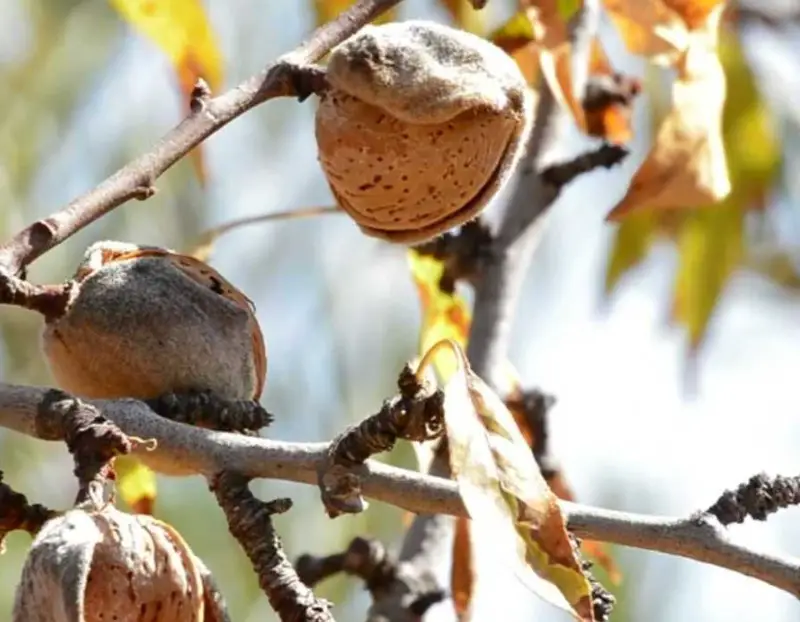
Butte almonds are a late-blooming variety known for their thick shells and high yields. They have a rich, nutty flavor and are often used in processed almond products. Their hard shells provide excellent protection against pests, making them a durable choice for commercial cultivation.
These almonds are characterized by their shorter, rounder shape and dark, ridged shells. The kernels inside are slightly smaller but have a strong, sweet taste. Butte almond trees are highly productive, featuring a dense growth habit with strong branches that support heavy nut loads.
Butte almonds thrive in USDA zones 7-9, flourishing in warm, dry climates with well-drained soils. They are extensively grown in California and perform well when planted alongside pollinators like Padre almonds to ensure high productivity.
Padre
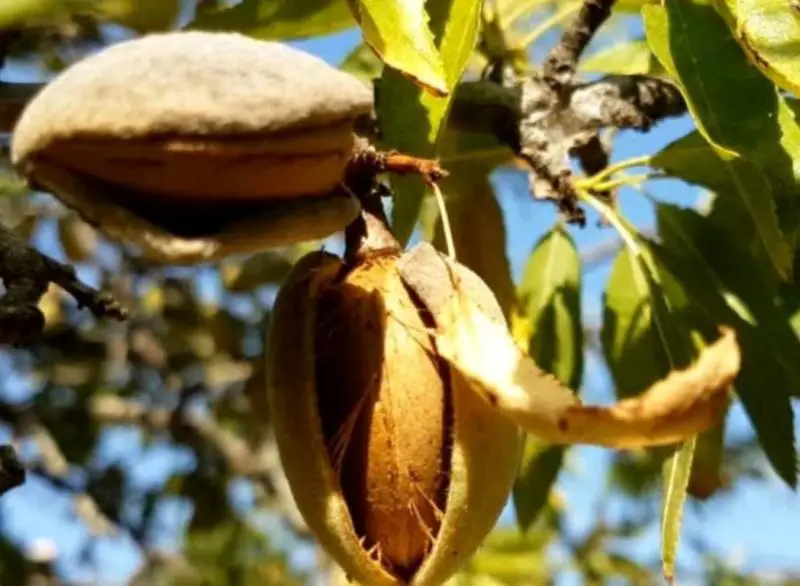
Padre almonds are a late-blooming variety known for their strong, hardy trees and high productivity. They have a hard shell, which offers excellent protection against pests and environmental stress. This variety is often grown alongside Butte almonds as a pollinator pair.
Padre almonds can be identified by their small to medium-sized kernels and thick, rough-textured shells. The kernels are typically darker and have a slightly wrinkled surface. The trees exhibit a compact, upright growth habit, making them well-suited for high-density planting.
Padre almonds thrive in USDA zones 7-9, performing best in regions with hot summers and well-drained soils. They are commonly cultivated in California’s Central Valley, where they benefit from consistent irrigation and good orchard management practices.
Monterey

Monterey almonds are known for their large, elongated kernels and high oil content, making them ideal for snacking and processing. They bloom slightly later than Nonpareil and serve as a good pollinator for multiple almond varieties. Monterey almonds are prized for their smooth texture and mild, sweet flavor.
This variety is easily identified by its long, narrow kernels and medium-thick shells. The nuts are typically lighter in color and have a softer texture compared to other hard-shelled varieties. Monterey almond trees have a vigorous growth habit with a spreading canopy, requiring regular pruning for optimal nut production.
Monterey almonds grow well in USDA zones 7-9, thriving in warm, arid regions with well-drained soils. They are widely cultivated in California, benefiting from a Mediterranean climate with long, dry summers. Regular irrigation and proper fertilization are key to maintaining healthy yields.
Fritz

Fritz almonds are a medium to late-blooming variety known for their hard shells and excellent storage quality. They are highly resistant to pests and mechanical damage, making them a preferred choice for commercial production. This variety is often used in processed almond products due to its firm texture.
Fritz almonds are identified by their small, compact kernels and thick, ridged shells. The kernels have a uniform shape and slightly darker color compared to Nonpareil. The trees grow vigorously with a dense canopy, requiring strategic pruning to optimize airflow and sunlight exposure.
Fritz almonds perform best in USDA zones 7-9, flourishing in hot, dry climates with well-drained soil. They are predominantly grown in California, where they require proper irrigation management and pollination partners like Nonpareil or Carmel for consistent yields.
Price

Price almonds are an early-blooming variety known for their thin shells and sweet, flavorful kernels. They are closely related to Nonpareil but tend to mature slightly earlier, making them a valuable addition to diversified almond orchards. Their delicate texture makes them ideal for raw consumption and confectionery uses.
This variety is distinguished by its smooth, paper-thin shells and elongated, light-colored kernels. The nuts are easy to crack open, revealing a soft, sweet-tasting kernel. Price almond trees have a moderately vigorous growth habit with an open canopy, facilitating better air circulation and sunlight penetration.
Price almonds thrive in USDA zones 7-9, preferring warm climates with well-drained soil. They are commonly cultivated in California and require cross-pollination with varieties like Nonpareil or Carmel for optimal production. Regular irrigation and fertilization are necessary to maintain high-quality yields.
All-In-One Almond Tree
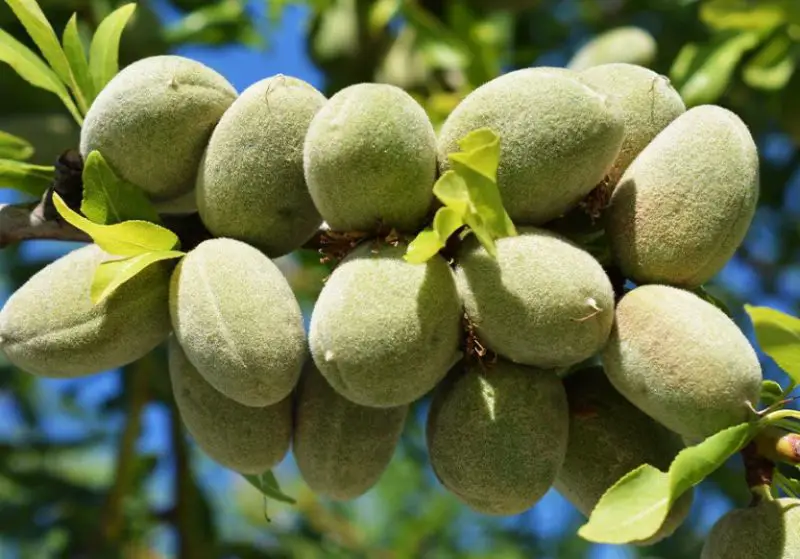
The All-In-One almond tree is a self-pollinating variety that is perfect for home gardeners and small-scale growers. It produces sweet, soft-shelled almonds with a rich flavor, making them ideal for fresh eating and baking. This variety is known for its compact size and reliable yields, making it a great choice for limited spaces.
Identifying the All-In-One almond tree is easy due to its smaller stature, typically reaching only 10-15 feet tall, much shorter than commercial varieties. The tree has an attractive, spreading canopy and produces showy pinkish-white blossoms in early spring. The almonds have a thin, papery shell, making them easy to crack open by hand.
The All-In-One almond tree thrives in USDA zones 5-9, making it one of the most cold-hardy almond varieties available. It performs well in warm, dry climates but can tolerate cooler temperatures better than traditional almond trees. With minimal maintenance, well-drained soil, and regular watering, this variety is an excellent option for backyard orchards.
Peerless

Peerless almonds are a unique, hard-shelled variety primarily used for in-shell almond production. They have a rich, nutty flavor and excellent storage capability, making them a favorite for whole-nut sales. Their thick shells offer superior protection against pests and environmental damage.
These almonds can be identified by their large, rounded shape and extremely hard, deeply grooved shells. The kernels inside are smaller compared to other varieties but are well-protected, ensuring a long shelf life. Peerless almond trees have a strong, upright growth habit with dense foliage, requiring regular pruning for optimal productivity.
Peerless almonds are well-suited for USDA zones 7-9, thriving in warm, dry regions with well-drained soils. They are widely cultivated in California and require reliable pollination partners like Nonpareil or Carmel to ensure high nut yields. Proper orchard management, including irrigation and pest control, is essential for maximizing production.
Tuono

Tuono almonds are an Italian variety known for their hard shells and high resistance to pests. They have a sweet, slightly oily kernel that is often used in confectionery and nut-based spreads. This variety blooms late, making it less susceptible to spring frosts.
Tuono almonds can be identified by their thick, rough-textured shells and medium-sized kernels. The kernels are slightly darker than Nonpareil and have a rich, nutty flavor. The trees have a compact growth habit and are highly productive, making them a popular choice for growers in Mediterranean climates.
Tuono almonds thrive in USDA zones 7-9, preferring warm, dry conditions with well-drained soils. They are commonly grown in southern Europe and require cross-pollination with varieties like Ferragnes for optimal nut production. Regular irrigation and proper pruning are essential for maintaining high yields.
Marcona
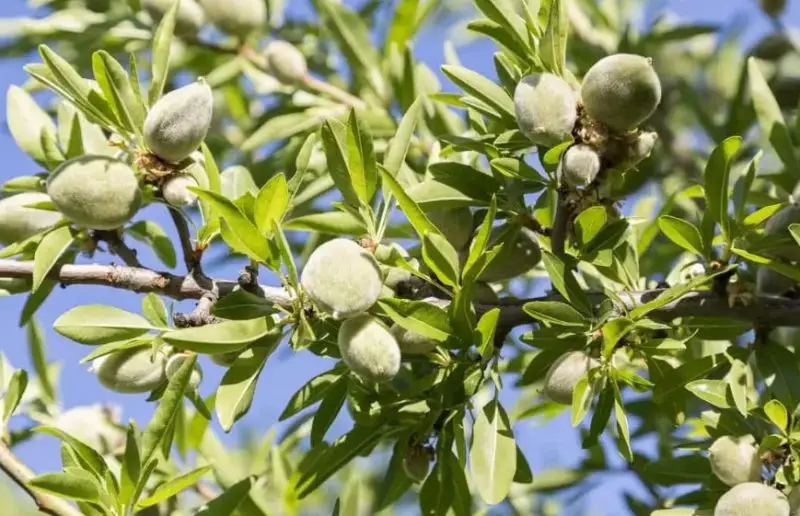
Marcona almonds are a Spanish variety prized for their round shape, buttery texture, and sweet flavor. They are often used in gourmet snacks and desserts, as well as in traditional Spanish cuisine. This variety has a lower oil content than most almonds, giving it a unique taste and mouthfeel.
These almonds are easily recognized by their short, plump shape and smooth, light-colored shells. The kernels are larger and rounder than most other varieties, with a soft, creamy texture. Marcona almond trees have a moderate growth habit and produce medium yields compared to commercial varieties like Nonpareil.
Marcona almonds grow best in USDA zones 8-9, requiring warm temperatures and well-drained, sandy soils. They are traditionally cultivated in Spain, especially in the Mediterranean regions, where they benefit from mild winters and long, dry summers.
Ferraduel

Ferraduel almonds are a French variety known for their hard shells and excellent resistance to late frosts. They have a slightly sweet flavor and firm texture, making them ideal for both raw consumption and processing. This variety is late-blooming, reducing the risk of damage from early spring temperature fluctuations.
Ferraduel almonds can be identified by their thick, ridged shells and elongated, uniform kernels. The nuts are well-protected, ensuring a long shelf life and resistance to pests. The trees exhibit strong, upright growth and produce consistently high yields when properly managed.
Ferraduel almonds thrive in USDA zones 7-9, performing best in Mediterranean climates with hot summers and well-drained soils. They are often grown in France and other parts of southern Europe, typically planted alongside Ferragnes almonds for cross-pollination.
Ferragnes

Ferragnes almonds are another popular French variety, known for their large, sweet kernels and high productivity. They have a slightly softer shell than Ferraduel but still offer good protection against pests and weather conditions. This variety is also late-blooming, making it more resistant to spring frosts.
This almond variety is characterized by its elongated, slightly pointed kernels and light brown shells. The kernels are sweet and firm, making them a preferred choice for premium almond-based products. Ferragnes almond trees are vigorous, with an upright growth habit and dense foliage.
Ferragnes almonds grow well in USDA zones 7-9, thriving in Mediterranean climates with warm, dry summers. They are commonly cultivated in France, Spain, and Italy, where they require well-drained soils and proper irrigation to achieve high yields.
Guara

Guara almonds are a self-fertile Spanish variety known for their high productivity and resistance to environmental stress. They produce sweet, flavorful kernels that are suitable for both raw consumption and processing. This variety blooms late, reducing the risk of frost damage.
Guara almonds are easy to recognize due to their medium-sized, elongated kernels and semi-hard shells. The shells are thinner than Ferraduel but still provide good protection against pests. The trees have a compact, bushy growth habit, making them well-suited for mechanized harvesting.
Guara almonds perform best in USDA zones 7-9, requiring warm, dry climates with well-drained soils. They are widely grown in Spain and other Mediterranean regions, where they benefit from minimal irrigation and low-maintenance orchard management.
Lauranne
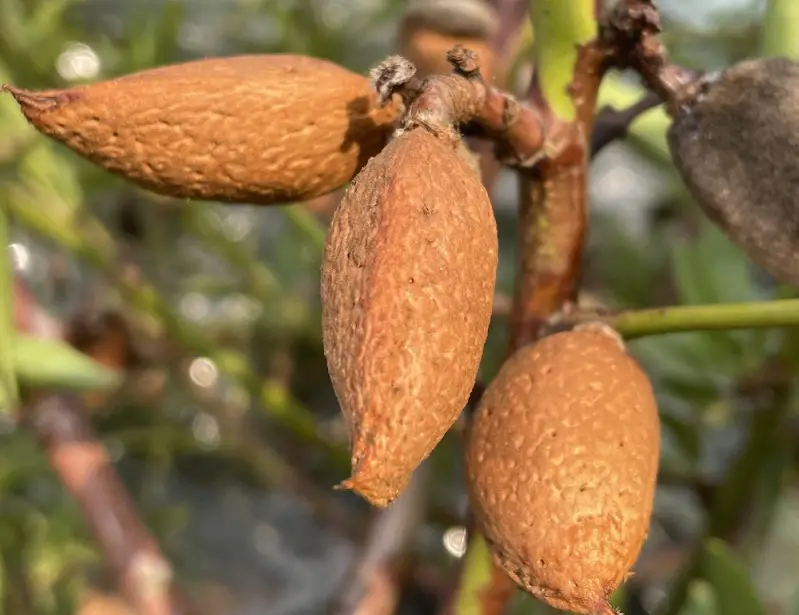
Lauranne almonds are a French hybrid variety developed for their self-fertility and strong resistance to diseases. They produce high yields of sweet, firm kernels that are commonly used in confectionery and baking. This variety is late-blooming, reducing exposure to spring frosts.
These almonds have a medium size, slightly pointed shape, and a smooth, light brown shell. The kernels inside are dense and uniform, with a well-balanced sweetness. Lauranne trees exhibit moderate growth with an open canopy, allowing for good air circulation and sunlight exposure.
Lauranne almonds thrive in USDA zones 7-9, favoring warm, dry climates with well-drained soils. They are particularly well-suited for cultivation in France and southern Europe, where they benefit from low-maintenance growing conditions and high resistance to common almond diseases.


